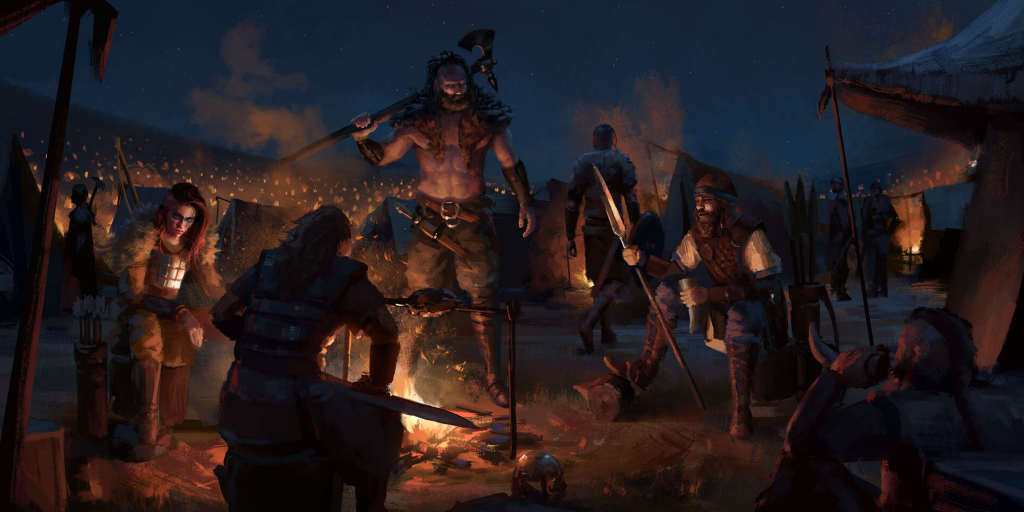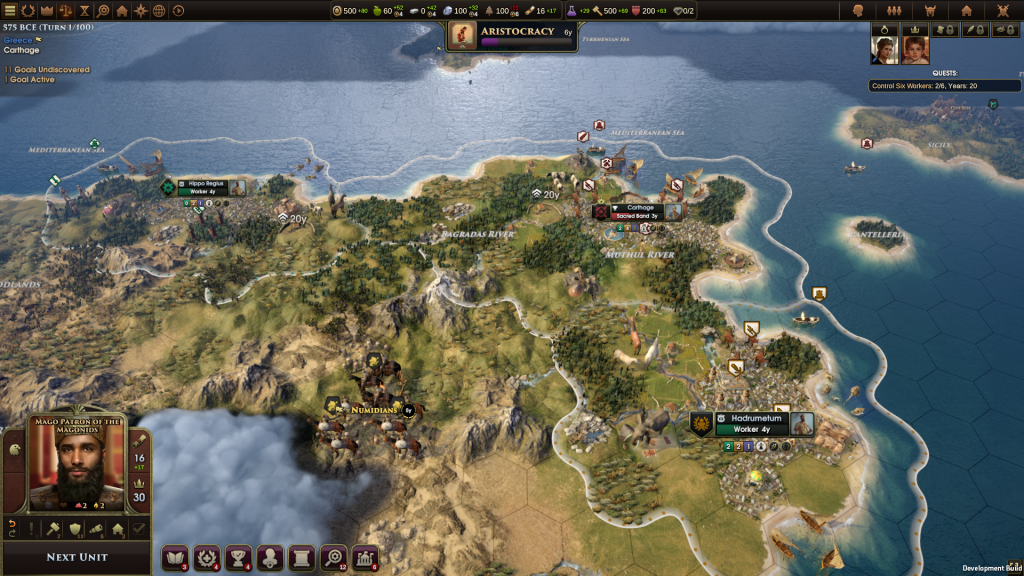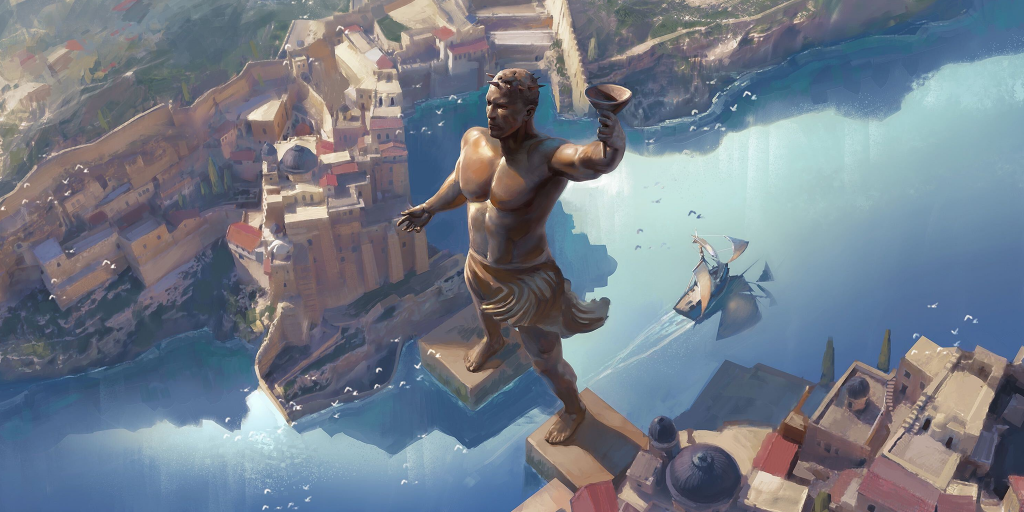If you have followed us for some time, you will already know we love Old World, a 4X game developed by Mohawk Games (who you might know from games such as Offworld Trading Company). With Old World being released in Early Access last year, we played many hours of the game. However, July saw the official release, so here is a full-fledged review of the game!
The 4X – narrative strategy hybrid
I’d like to describe Old World as a hybrid between a 4X and a narrative-driven strategy like Crusader Kings, set in ancient times, where you play as either Rome, Babylon, Carthage, Egypt, Assyria, Persia or Greece. It takes the 4X elements, such as city management, tile improvements and exploration of the lands, from famous 4X’s as Civilization. That isn’t surprising as Soren Johnson, who worked on Civ III and Civ IV, is the Design Director for Mohawk Games. Old World expands on the normal 4X experience with narrative events, families and personal development, like you’d see in Crusader Kings. Instead of playing one ruler like in Civ, you now play as a dynasty.
Each of your dynastical rulers can have a different playstyle. For example, you can play as a hardened warrior-general, who rules his lands with an iron fist. But his heir can be the most compassionate diplomat the world has ever seen. This certainly mixes up the playstyle. Aside from all the exploring, expanding, exploiting and exterminating, you now also got to worry about your heirs doing stupid things and families fighting over influence. This all seems like a big nuisance, but it is actually what makes Old World such a good game. It takes the strengths of both worlds, and develops that into a wonderful game. The fact that you are not only drawn into the game by expanding your empire but also by a narrative makes the hours fly by as you play.
Making Barbarians into people
Another thing which makes Old World such a unique game is its take on the ‘non-civilized’ people of the ancient world. Besides the seven playable nations, many other people inhabited the regions of the Middle East and the Meditteranean. Take the Gauls, Lybians and the Numidians for example. Many 4X games would make these peoples into ruthless barbarians, without a culture or a homeland. Old World takes another approach and adds these cultures and peoples as tribes. They are no barbarians, although they do raid from time to time, but real diplomatic units you can declare war on, but also alliance with. It wasn’t uncommon for larger nations to ally with smaller tribes, as Hannibal did with the Gauls during his invasion of Rome.
Besides these tribes, the game also has some barbarians who cannot be reasoned with: they will attack. Old World has an amazing scenario made around barbarians, where it’s basically you against a horde of barbarians. And when I say horde, I mean horde. Prepare for 50+ barbarian horsemen. Aside from this silly scenario, Old World also provides some real cool historical scenarios (or will in the future). The first one is centered around Carthage. Split up into four different games, you will play from the start, through the rise and the eventual conflict with the Romans towards the downfall of the Carthaginian Empire. You’ll learn about the struggles the Carthaginians went through and how hard it is to march an army with elephants over the Alps.

Order, order, order!
Old World isn’t only innovative in its takes on ‘non-civilized’ people and the awesome mix of 4X and narrative, but also on how it approaches government. Like many 4X, Old World employs a system where you’re limited in what you can do in a turn. But instead of limiting all the units individually (like Civ), Old World limits your entire empire. You have a limited number of orders each turn. With orders, you can command your military around and your workforce. Although you can expand the number of orders you gain each turn, you are often limited by them and cannot do everything you want to do each turn. It would not be the first time my workers are just standing there doing nothing because I’m fighting a war and use up all my orders to move and attack.
Besides being a useful game mechanic, it also shows the complexity of governing an empire, waging war and improving your lands. As a ruler, you have to make decisions. Do I want a lumber mill over here, or do I want to attack this one unit? The system makes you really think about your decisions, which doesn’t always work out well if you’re a fast clicker like me. Fortunately, Old World has something for that!
My love: the undo button
Now I am not one for save-scumming, but sometimes you just have to revert to an older save because you either did something stupid or just misclicked (which can be costly in a game with limited moves per turn). Well, Old World saves you the reloading of saves as it actually has an undo button! Yes, a real button that instantly reverts your misclicks, stupid mistakes and even the decisions you have made in a narrative event. You can literally undo the past! I need this feature in my own life and, while we’re at it, why not have it world history as a whole! All jokes aside, this is one of the best things Old World does. Just this small button makes your life so much easier!

The art and UI amazing
Mechanics and content are one thing, but how a game looks is also quite important. Well, luckily for us the people of Mohawk Games have hired some very talented artists and have made some awesome game art. I mean, just look at some of the art in this piece. Besides the amazing art, the game itself also doesn’t look too shabby. It really takes you back to the older Civilization games (IV and V). That is not weird when you consider Johnson’s former work. Besides the visuals, Mohawk has also provided us with a pretty cool preview of the units engaging in battle (alike Total War). It’s a cool extra visual to have.

With cool art and visuals also comes a very good UI. Sometimes I wonder if it’s actually hard to design a good UI, and it probably is, but Old World’s UI is pretty sleek. It doesn’t take up too much of the screen and is intuitive. There might be a lot happening, but if you’re a bit versed in 4X or other strategy games, it won’t take you too long to get used to it. The game even provides some good tool-tipping and the ability to freeze tooltips so you can actually read them!
Verdict
We’ve given love to Old World multiple times on this website and during our streams. It is clear that we like it quite a bit. It is innovative, takes the best of 4X and narrative/character-driven games as Crusader Kings and shows how 4X’ can keep evolving and experimenting with new mechanics. The way it portrays the ‘non-civs’ in the game deserves credit, and the art and visuals are just plain amazing.
It is unfortunate that I am still comparing it to games like Civ, where I should really be talking about just Old World. But the comparison to Civ will always be made, as that is the godfather of 4X’. Nevertheless, Mohawk Games have set a new standard for these types of games with Old World. It has successfully shown that you can have a historical narrative in such a game, whilst still keeping the intrinsic elements of a 4X. And it didn’t even take a massive development team, and Christopher Tin’s title song isn’t even in the game yet! If I were to give you a recommendation for a game, it would be Old World. You’ll like it, trust me.
You can buy Old World at the Epic Store for €32,99 (but it’s discounted now)!

Omar ‘oomzer’ Bugter is a Cultural Historian from Utrecht. Since interning at VALUE, he’s stuck around, mainly working on the Interactive Pasts website and the weekly streams. He wrote a thesis on Sid Meier’s Civilization VI and mods, so knows this game very well. He likes many other games, including F1 2020, Hearts of Iron, Mount & Blade and Crusader Kings III., and is VALUE’s in house city builder connaisseur. Tweet to him at @oomzer if you want to know anything about Civ or city builders.
